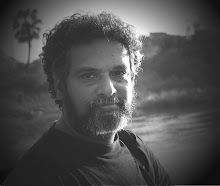Outrageous, Hilarious, Unassuming…
It was all surprises, pure entertainment, and pure theatre in its raw rustic energy. The 150 minutes of musical (!) Vastraharan in Malvanai dialect of Marathi, performed by Bhadrakalai productions Mumbai, written by G. Gavankar and directed by late Ramesh Randive, was a comedy of all sorts. A play that was first performed by a group of amateur actors who are mill workers, now completed 5130 shows (inclusive of yesterdays as Sri Ram Centre. It was first performed in Mumbai in 1980, and is continuously running as the biggest hit on the commercial Marathi stage.

Then it is all comedy, comedy of errors, errors of all sorts – comedy of action, situation, caricaturing, cartooning, verbal comedy, wits, satire, mispronunciation, mistaken entries, ridiculing the current political situation (when the prompter corrects the dialogue of one actor, the village head warns that he can say anything and be careful with him, since he is a politician belonging to the Maharashtra Navanirman Sena !). None including the actors, musicians, politicians including Raj Thakeray and Manmohan Singh, not even commonwealth games and Konkan Railway were spared! Dhrutharashtra is called as Maharashtra, the actor acting as Lord Indra gets possessed and demands a dance by a Lavani dancer (he has spotted one in the audience), Vidura comes smoking a beedi, the blind king Dhrutharashtra wearing a glass, and Durytodhana without a headgear, (the actor acting the role of a servant has put up glittering costumes, and ornaments including the crown!), etc to list a few incidents that initiates laughter. And finally the ‘the wife of Draupadi’ has given birth to a boy child after 7 girls and the actor is fully boozed in happiness and is missing, leaving the Lavani dancer to enact as Draupadi. She has to just appear at the right time, with loosened hair, crying and the rest other actors will do, she has to simply finish the act and leave; very simple!

The play is so simple and unassuming. We can say it is Brehtian since everything is open and exposed no melodrama, neither catharsis. We can say this is a postmodern dissemination of a society and a discourse on play making itself. But the play itself is unassuming and direct as possible; it is the sheer show of actors, their histrionics, body language with perfect timing, negation of all aesthetics and concerns regarding the form and structure. At times we can say that there are excesses and playing out for the clap of the audience; after all who decides the border and limits?
Kutiyattam by Margi Madhu and Nangiar Koothu by Margi Sathi
Margi Madhu and Margi sathi represented the oldest living theatre form Kutiyattam in the festival of performance festival. Madhu selected to perform Sankhaksheeravapussu .. from Balacharitham written by Bhasa, a piece usually used for the Arangettam (the first performance). This act gave him the [possibilities to portray varied emotions including veera, Bheebhalsa, Karuna, etc. The three avatars of lord Vishnu (Narasimha, Vamana, and Rama) are crammed into the 80 minutes of his performance. Out of the three different segments the Mahabali –Vamana episode stood out. The form of Kutiyattam that allows transforming from one character to another, to travel in time forward and backward, from response to cause, from reaction to action and backward, present to past,from moments of brisk action to stillness, from the loud percussion on Mizhavu to silence, externalizing the internal rhythm etc was apparent in the show. The death scene of Ravana echoed the famous death scene of Bali enacted by the legendary actor Ammannoor Madhava Chakyar.

Dance of the Deserts – Kamal Jabri and Group

Navtej Singh Johar presented “The grass is singing”, the first and one of the greatest books of on Doris Lessing. This novel, written almost entirely in the form of an extended flashback, details the mental, spiritual, financial and marital disintegration of Dick and Mary Turner, white farmers struggling to make a living off a sun-baked farm in South Africa. Navtej Johar is a Bharatanatyam exponent and a choreographer, whose work freely traverses between the traditional and the contemporary.
Priti Patel’s presentation is based on the verses of Bangladesh’s Poet Jasimuddin’s ‘Nakshi Kanthar Math’. The work has been hailed a masterpiece because of its simplicity, its charm and its deep humanity. In this saga of loss and separation, hunger and frustration, the villager displays the values of constancy, courage, love and hope. Observed SNA’s Secretary, Jayant Kastuar, “Navtej Johar’s treatment of a complete novel on a theme of racist Africa in a short performance was bold & successful. On the other hand Priti Patel’s rendition of Jasimuddin’s poem from Bangladesh in her inimitable Manipuri style fused with Bengali rendition was very touching.”
Earelier there was a show of Manipuri dance- a meditative and introvert from by itself. The dancers seem to be in an act of communication with the surroundings and the ultimate and are not in touch or aware of the audience. The movements are circular and continuous, each merging into the other. The Pung, a drum, and flute are the principal instruments used in Manipuri dance.
Kuchipudi is an all-male dance-drama tradition that takes its name from Kuchipudi village in Krishna district, Andhra Pradesh Students of Jayarama Rao trained in the Kuchipudi Dance Academy performed Kuchipudi dance in the festival.
“The Manipuri tradition of Sangeetam and Raslila is part of the living culture of the state took us to great heights of ecstasy in today’s performance, while Kuchipudi performers of Andhra tradition, dazzled the audience with their verve and vivacity. Each tradition presented in exclusively designed stage sets”, said Jayant Kastuar.
Photos : Chandradasan



2 Comments:
good work,thanx for sharing the beautiful moments
Hai Sir,
It gives me a live experience of the programmes. Essenceful writing, effervescent reporting and of course excellent sharing....
Post a Comment
Subscribe to Post Comments [Atom]
<< Home